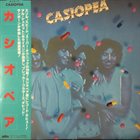 3.34
3.34 |
5 ratings

snobb
Japan found out about jazz fusion soon after fusion took over the scenes in America and Europe. Early Japanese fusion bands were strongly influenced by Western artists and were quite experimental and rough the same way.
In the late 70s, when Western fusion lost its bite and identity mixed with upcoming disco and smooth jazz, Japan experienced the Second wave of Japanese fusion. Generally oriented the same way as in the Western world, the second wave of Japanese fusion found its special sound and gave birth to a J-fusion phenomenon. Some of the genre's bands started their career in the late 70s, and are active and even popular till now, almost a half-century long. Casiopea is one of them.
Founded in 1976, the Japanese guitar-led quartet released their debut in 1979 only. For marketing reasons, there are three renowned Western fusion stars, participating in this album - sax players David Sanborn and Michael Brecker plus trumpeter Randy Brecker. Still, their participation influences the album's music only in a small part, "Casiopea" sounds very much like one of many albums, released by the band themselves, without guests.
From almost half a century distance it's much more easy to evaluate, why this album has so many fans and experienced all series of re-releases (last re-issue comes in 2024). Typically for the leading band of J-fusion's second wave, Casiopea plays a mix of some popular genres of the time - from Mahavishnu Orchestra-like high-energy guitar fusion to well-arranged pop-jazz, to early smooth jazz and funk-jazz. Their sound is generally well-polished and characteristic of the late 70s. It has millions of haters nowadays and not without reason, still Casiopea's debut has almost cult status till now.
The main secret is that the band plays tuneful music with the highest level of precision (usual for many Japanese artists of the time), but the music itself is warm and emotionally colored. The sound mix is crisp and dry, but again - it successfully balanced on the red line, distinguishing it from muzak. In all, this album represents a concentrated late 70s jazz fusion values almost neutralizing the well-known genre's limitations.
The album's opener "Time Limit" is a guitar-lead high-energy piece in a key of John McLaughlin's works with an excellent drummer and dancing bass line. The guest brass section is active here as well, it still doesn't add a lot of blood to the piece. "Tears Of The Star" is a lyrical ballad with soloing sax, Latin-like guitar intros besides of electric guitar soloing, and quite tasteful arrangements. "Space Road" is a funky instrumental, recalling the soundtrack of early computer games. "Midnight Rendezvous" has a catchy melody and sounds pretty much like a Japanese pop song of the time.
Side B is not as strong, as Side A. "Far Away" opens with groovy bass and switches towards a key-lead popular tune, still perfectly arranged. "Swallow" still has great bass and drum lines, but tends to be a smooth jazz hit. "Dream Hill" is probably the most controversial album's song, a sweet pop-ballad with Japanese vocals. The closer "Black Jake" saves the situation a bit offering a faster and more energetic guitar-lead piece.
In all, Casiopea's debut is significant evidence of the time and a great starting point for understanding what the Japanese fusion phenomenon is about. This album gave a lot of inspiration (and citation) to early computer games creators and is popular with every young generation again and again (in most current times its music is tagged as "City pop" genre).